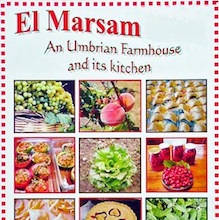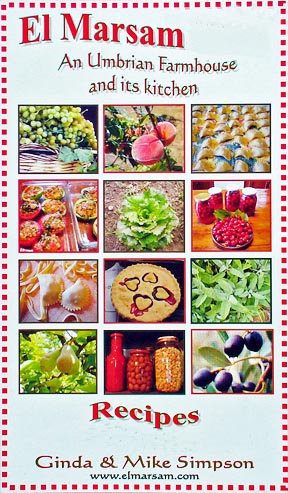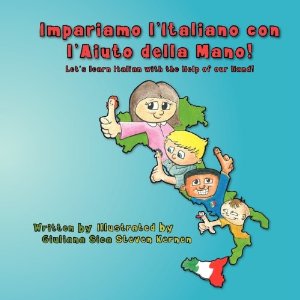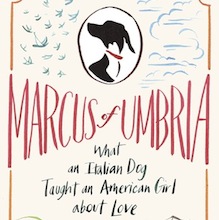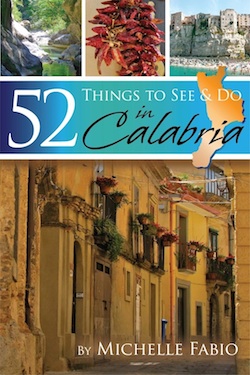Archive for the ‘books’ Category
El Marsam B&B Cookbook: An Umbrian Farmhouse and Its Kitchen
 Kicking off the Gita Italiana 2010 is a review of my friend Ginda Simpson’s wonderful new cookbook, El Marsam B&B: An Umbrian Farmhouse and Its Kitchen.
Kicking off the Gita Italiana 2010 is a review of my friend Ginda Simpson’s wonderful new cookbook, El Marsam B&B: An Umbrian Farmhouse and Its Kitchen.
If you’ve been around Bleeding Espresso for a while, you might remember Ginda from when I wrote about her first book, Deeply Rooted, in faith & family. Ginda’s family has roots in Calabria, but she has made her home in Umbria, where she operated the El Marsam B&B for many years and also creates gorgeous paintings (which was also featured in the previous post).
Ginda’s cookbook is full of great recipes from Artichoke Chicken to Zuppa Frantoiana (Tuscan white bean soup), but if that isn’t enough to draw you in, you will love reading the anecdotes sprinkled throughout the book that tie all the dishes together. With some snippets you’ll learn the history of a recipe or a cultural tradition, with others you’ll devour how certain foods came into Ginda’s life, and then, of course, there’s my favorite — the one about the shepherd in Calabria making pecorino as it’s been made for centuries.
Ginda’s writing style is friendly and conversational, so you’ll feel like you have a supportive guide in the kitchen with you as you work your way through 70 gorgeous recipes; if you’re like me, though, you’ll read through all the stories first and then backtrack through the recipes, re-reading the stories as you make your way through the book again. I haven’t tried any recipes yet as our kitchen slows down considerably in the summer, but I’ve already marked off the first three I’ll try: Farfalle with Speck & Rucola, Red Pepper Jam, and Cappuccino Mousse. Yum!
If you’d like to purchase Ginda’s cookbook and learn more about her art, writing, and life in the Umbrian countryside, you can do so at GindaSimpson.com.
*
Subscribe to my Book Reviews feed — book reviews ONLY, which aren’t published to the main feed — by visiting Feedburner.
Impariamo l’Italiano con l’Aiuto della Mano! by Giuliana Sica
Impariamo l’Italiano is eye-catching, informative, engaging, and the illustrations are downright adorable.
Read on...Marcus of Umbria by Justine van der Leun
 Marcus of Umbria: What an Italian Dog Taught an American Girl About Love by Justine van der Leun is about a young American woman who moves to a small, rural village in Italy on a whim and ends up falling in love with a dog.
Marcus of Umbria: What an Italian Dog Taught an American Girl About Love by Justine van der Leun is about a young American woman who moves to a small, rural village in Italy on a whim and ends up falling in love with a dog.
Does it surprise you that I really, really enjoyed this book?
After becoming smitten with a local Italian ragazzo on vacation, the author packs up her New York City life and transplants herself to Collelungo in Umbria, the Green Heart of Italy. She immediately becomes part of the family, and she is expected to contribute as such. I think it’s safe to say this is her first of many culture shocks detailed throughout the book.
As we learn more about Justine’s new surroundings and the people playing prominent roles in her daily life, we also get to know the author through how she handles new, challenging situations. The picture isn’t always pretty, but it certainly seems honest. Being able to trust the author of a memoir is always a huge plus.
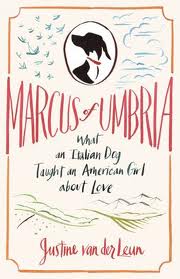 Justine’s time in the village wasn’t full of leisurely days sipping wine under the Umbrian sun and raucous family gatherings by night, and she pulls no punches on this anti-Under the Tuscan Sun lifestyle she adopts. Her fidanzato isn’t the most attentive (although he seems like a good enough guy), his brother has a cruel streak to say the least, and common methods of keeping and training animals are heart-wrenching to animal lovers.
Justine’s time in the village wasn’t full of leisurely days sipping wine under the Umbrian sun and raucous family gatherings by night, and she pulls no punches on this anti-Under the Tuscan Sun lifestyle she adopts. Her fidanzato isn’t the most attentive (although he seems like a good enough guy), his brother has a cruel streak to say the least, and common methods of keeping and training animals are heart-wrenching to animal lovers.
Justine manages to present these tidbits and others in a very matter-of-fact way though, without judgment. It is what it is, if you will, and in many instances, it’s been that way for centuries in Collelungo (and other small towns throughout Italy). I can’t speak for what the people of Collelungo might think about Justine’s perceptions as related in the book, but from my perspective in what seems to be a similar village, they rang fairly accurate.
But through all the ups and downs of life in Collelungo, Justine’s growing love for Marcus, an English pointer she rescues, keeps her grounded — in fact, literally, as she is reluctant to leave town even after her love affair has soured, not knowing what will happen to her beloved pooch. Indeed, the only issue I had with the book is that I would have liked more Marcus!
Witty, descriptive, well-crafted, and just plain entertaining, this book gets four and a half espresso cups out of five; more Marcus would’ve had my cup runneth-ing over. Marcus of Umbria is more about Justine’s year living in rural Italy than simply a girl meets dog tale, but what it does, it does well — so I highly recommend it.
P.S. You can also “like” Marcus of Umbria on Facebook and follow Justine @justinevdl on Twitter.
*
Subscribe to my Book Reviews feed — book reviews ONLY, which aren’t published to the main feed — by visiting Feedburner.
The Chamberlain Litany by Peter T. Marsh
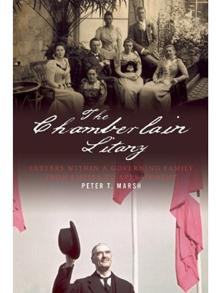 I got a copy of The Chamberlain Litany by Peter T. Marsh from Haus Publishing, who you may remember also published The Mystery of Lewis Carroll by Jenny Woolf. I was particularly intrigued by the description following the title of the book, “Letters Within a Governing Family from Empire to Appeasement.”
I got a copy of The Chamberlain Litany by Peter T. Marsh from Haus Publishing, who you may remember also published The Mystery of Lewis Carroll by Jenny Woolf. I was particularly intrigued by the description following the title of the book, “Letters Within a Governing Family from Empire to Appeasement.”
I will admit to knowing very little of early 20th century British history and even less about the Chamberlain family, and these were two reasons I was interested in reading this book — to learn. The other reason was because I absolutely adore reading personal and family histories through people’s own hands, through their written words preserved over the years.
The Chamberlain Litany paints a fascinating portrait of one of the most prominent and powerful British political families, which included patriarch and statesman Joseph, sons Sir Joseph Austen (statesman and recipient of the Nobel Peace Prize) and Neville (UK Prime Minister from 1937-1940), and daughters Beatrice, Ida, Hilda, and Ethel.
Marsh’s writing is engaging, clear, and his contentions are well-supported through extensive research. The most interesting aspect of the book to me was how much the daughters were involved in political discussions and debate — and that their opinions were well-respected; of course with that respect came somewhat of an obligation to support and help sustain the males’ political careers, which may have been part of the reason three of the four sisters never married. It seems to me a book about the Chamberlain women would be a worthy pursuit as well.
The Chamberlain Litany also speaks to my American history interests as well as to my passion for Italy; various members of the family interact with the likes of Theodore Roosevelt, Henry Cabot Lodge, and other notable Americans of the time. The Chamberlains also spend a lot of time in Italy, and, on the political side, there is, of course, plenty of talk of Il Duce himself, Benito Mussolini. That said, the sections about Neville’s relationship with Adolf Hitler and how appeasement came to be are surely highlights for the universal reader.
I should mention, though, that you don’t have to worry if you don’t know much about early 20th century British history; Marsh includes a handy timeline in the back of the book to catch you up to speed.
My only real criticism, if you can call it that, is that I would have liked to have seen more full letters reprinted, without necessarily being woven into a larger narrative via snippets. While the latter is certainly a useful and effective writing technique, it did take away from some of the personality of the letters that otherwise may have come through.
Overall, I would say if this a topic you feel like you’d be interested in, this is a worthy read. I would recommend, though, that if you don’t know much about the Chamberlains, read some background information on them to get you interested in their lives. This is a nonfiction book, so there isn’t the same kind of character development you might see in a novel — and if you don’t give a whit about the main players in the book from early on, you might lose interest, and that would be a shame.
*
Subscribe to my Book Reviews feed — book reviews ONLY, which aren’t published to the main feed — by visiting Feedburner.
Murder in Italy by Candace Dempsey: Amanda Knox Trial
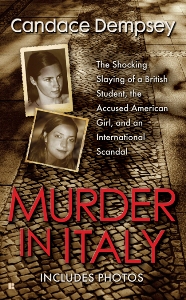 One of the biggest and most tragic stories to emerge from Italy in the past few years is the murder of Meredith Kercher, a 21-year-old English woman studying in Perugia. Kercher died in a pool of her own blood after being stabbed in the neck. And those are about all the details of this case that everyone can agree about.
One of the biggest and most tragic stories to emerge from Italy in the past few years is the murder of Meredith Kercher, a 21-year-old English woman studying in Perugia. Kercher died in a pool of her own blood after being stabbed in the neck. And those are about all the details of this case that everyone can agree about.
What has captured the attention and intrigue of many outside of Italy is the fact that an American student and Kercher’s roommate, Amanda Knox, was convicted of playing a role in Kercher’s death. Knox is currently serving a 26-year prison sentence along with Raffaele Sollecito, her Pugliese friend (I just can’t call him her “boyfriend” as he’s often called; they had been seeing each other for about a week before the murder), and Rudy Guede, a native of the Ivory Coast who had been adopted into an Italian family at a young age. Sollecito is serving 25 years in prison and Guede 16. All have upcoming appeals.
*
Candace Dempsey‘s book Murder in Italy: The Shocking Slaying of a British Student, the Accused American Girl, and an International Scandal sets out to tell the real story beyond the “media frenzy,” according to the backcover blurb.
Full disclosure: I received a review copy of the book and have known Candace since before Kercher’s murder (Candace’s family comes from Calabria so that is how we initially “met” online). In fact, Candace and I exchanged several emails about the case throughout the investigation. Candace soon began writing about the case on her blog Italian Woman at the Table, and it’s no secret that Candace has been an *extremely* strong supporter of Knox from early on — and although I know Candace tried hard to be objective, that support continues in this book.
I’m sorry to say that Murder in Italy wouldn’t be my first choice to get a balanced account of the facts of this case, although to be fair, I’m not sure if one exists anywhere as there are strong emotions on all sides. In Murder in Italy, the choice of evidence discussed, the way it’s presented, phrasing, and word choice all paint Amanda as innocent and the Italian police and judicial system as idiots at best, intentionally framing innocent people at worst.
 That said, the book covers the main events of the case well, offers details in matters that haven’t been greatly publicized, and delves into the personal backgrounds of many of the major players. For anyone interested in this case, you can find a lot of background information and become familiar with one perspective of what happened. To be honest, I didn’t read anything in the book that I hadn’t heard before, but I had been following the case fairly closely as a legal geek.
That said, the book covers the main events of the case well, offers details in matters that haven’t been greatly publicized, and delves into the personal backgrounds of many of the major players. For anyone interested in this case, you can find a lot of background information and become familiar with one perspective of what happened. To be honest, I didn’t read anything in the book that I hadn’t heard before, but I had been following the case fairly closely as a legal geek.
Aside from that, though, some little things bothered me throughout the book — misspelled/misused Italian words, sweeping generalizations about Italians and their beliefs, inconsistencies in Knox’s and Sollecito’s statements that were never addressed let alone explained, repeated themes without proof behind them (Knox’s Italian is described as very basic and even poor, but I’ve heard her speak Italian, and it’s not) and various phrases in quotes that aren’t attributed to any sources. To put it mildly, the editing should have been much tighter, and I chalk that up to the publisher wanting to get this out as fast as possible.
But the final verdict: would I recommend this book? Yes, I would, largely because of its most promising quality that I haven’t touched upon yet: readability.
Murder in Italy reads like a novel with so many plot twists and turns and complex characters, you won’t want to put it down. In fact, I read this in a couple days, never losing interest even though I already knew the essentials of the story. Candace has said that she wanted to write about the story as a dream turned into a nightmare, and she accomplished that. She also did a great job of painting the scene in Perugia and giving readers a little peek into this unique corner of Italy where a new crop of young foreigners pass through all the time.
So if you’re interested in the Amanda Knox case and/or enjoy true crime books, give Murder in Italy a look, knowing that you’re in for an engaging although not impartial read.
*
If you’d like to hear Candace talk about her book, Perugia, and more, check out our latest Eye on Italy podcast in which we also discuss the possible death of Nutella and blue mozzarella.
*
Subscribe to my Book Reviews feed — book reviews ONLY, which aren’t published to the main feed — by visiting Feedburner.

